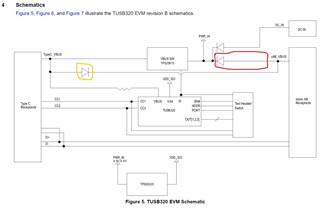Other Parts Discussed in Thread: TPS25910
Hi,
We use TUSB320 on one of our evaluation board.
We want to use DRD mode (Host/Device) - more or less OTG in USB notation.
The TUSB320 shall convert the USB interface from our MicroProcessor (USB 2.0 with PWR, VBUS, ID, OC, ... pins) to a USB-C connector with CC handshake.
I have studied some schematics (from different sources) and it is not clear for me how to handle following topics:
ID pin and PWR pin:
In some designs I saw that the ID pin is just connected to the input of the MicroController with the USB interface. In other designs I saw that additionally the ID PIN output from TUSB is used to enable the Power switch.
In the designs, where ID pin is just used as input for the MicroController, the MicroControllers output "USB_PWR" is used to control the enable of the Power Switch.
Which solution is prefered / has highest stability?
VBUS:
When our device acts as a host (DFP), VBUS must be delivered by the Power switch. In such a case a capacity of some µF also used to stabilize the energy there.
If we then switch to peripheral (UFP) mode, we should only listen (sense) if VBUS is present. But how to handle the capacitor, which takes some time to discharge. It will tell me that there is VBUS present but there is nothing connected ...
How is this normally handled?
Additional info:
We plan to use NO I2C interface. We just want let pin PORT and ADDR in NC state. Do you see any problems here?
Would be great to get some answer - many thanks!






